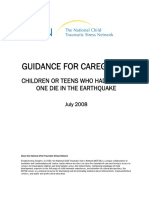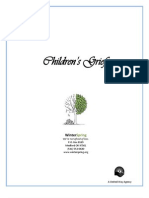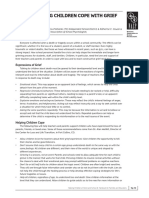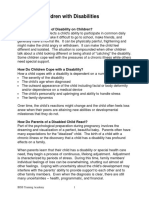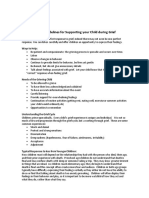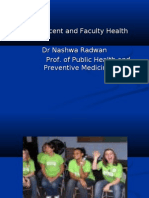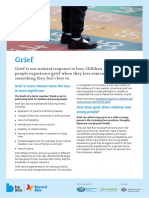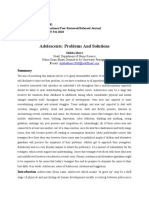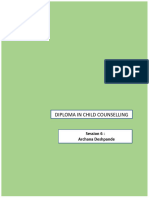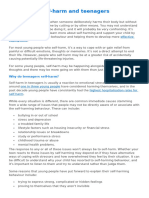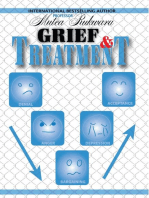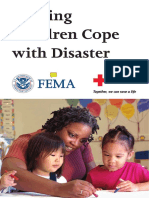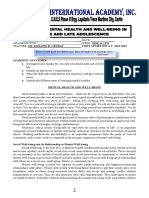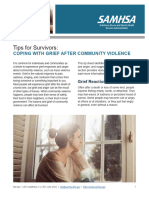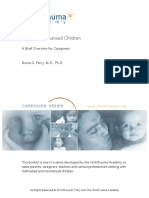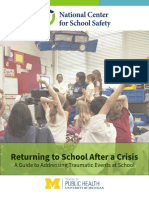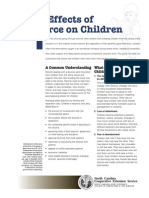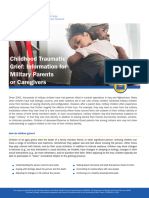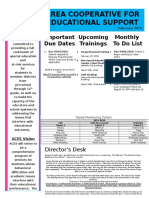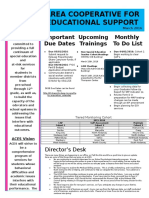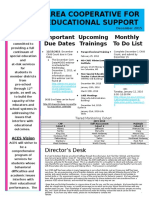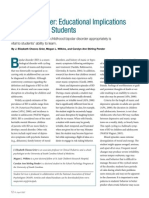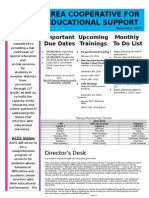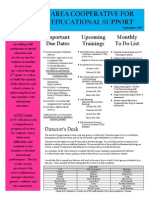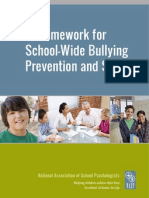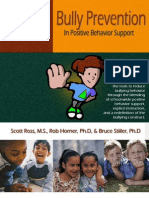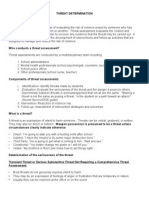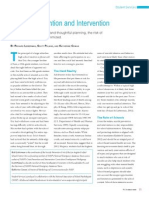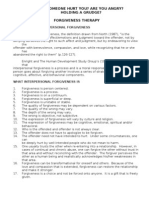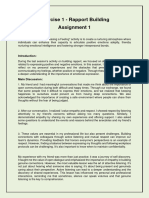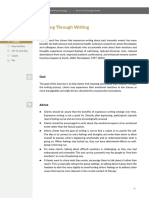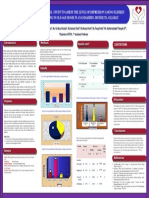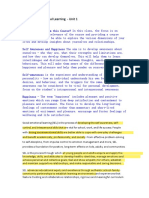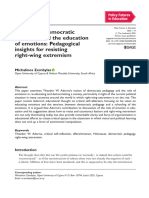Death and Grief:: Supporting Children and Youth
Death and Grief:: Supporting Children and Youth
Uploaded by
api-83101465Copyright:
Available Formats
Death and Grief:: Supporting Children and Youth
Death and Grief:: Supporting Children and Youth
Uploaded by
api-83101465Original Title
Copyright
Available Formats
Share this document
Did you find this document useful?
Is this content inappropriate?
Copyright:
Available Formats
Death and Grief:: Supporting Children and Youth
Death and Grief:: Supporting Children and Youth
Uploaded by
api-83101465Copyright:
Available Formats
Supporting Children and Youth
Death and Grief:
Death and loss within a school community can affect anyone, particularly children and adolescents. Whether the death of a classmate, family member, or staff member, students may need support in coping with their grief. Reactions will vary depending on the circumstances of the death and how wellknown the deceased is both to individual students and to the school community at-large. Students who have lost a family member or someone close to them will need particular attention. It is important for adults to understand the reactions they may observe and to be able to identify children or adolescents who require support. Parents, teachers, and other caregivers should also understand how their own grief reactions and responses to a loss may impact the experience of a child. GRIEF REACTIONS There is no right or wrong way to react to a loss. No two individuals will react in exactly the same way. Grief reactions among children and adolescents are influenced by their developmental level, personal characteristics, mental health, family and cultural influences, and previous exposure to crisis, death, and loss. However, some general trends exist that can help adults understand typical and atypical reactions of bereaved children. Sadness, confusion, and anxiety are among the most common grief responses and are likely to occur for children of all ages. The Grief Process Although grief does not follow a specified pattern, there are common stages that children and adolescents may experience with varying sequencing and intensity. The general stages of the grief process are: Denial (unwillingness to discuss the loss) Anger or guilt (blaming others for the loss) Sorrow or depression (loss of energy, appetite, or interest in activities) Bargaining (attempts to regain control by making promises or changes in one s life) Acceptance or admission (acceptance that loss is final, real, significant, and painful) Grief Reactions of Concern The above behaviors are expected and natural reactions to a loss. However, the following behaviors may warrant further attention:
Preschool Level:
Decreased verbalization Increased anxiety (e.g., clinginess, fear of separation) Regressive behaviors (e.g., bedwetting, thumb sucking) Difficulty concentrating or inattention Somatic complaints (e.g., headaches, stomach problems) Sleep disturbances (e.g., nightmares, fear of the dark) Repeated telling and acting out of the event Withdrawal Increased irritability, disruptive behavior, or aggressive behavior Increased anxiety (e.g., clinging, whining) Depression, guilt, or anger 1
Elementary school level:
Middle and high school level:
Flashbacks Emotional numbing or depression Nightmares Avoidance or withdrawal Peer relationship problems Substance abuse or other high-risk behavior
Signs That Additional Help Is Needed Adults should be particularly alert to any of the following as indicators that trained mental health professional (school psychologist or counselor) should be consulted for intervention and possible referral: Severe loss of interest in daily activities (e.g., extracurricular activities and friends) Disruption in ability to eat or sleep School refusal Fear of being alone Repeated wish to join the deceased Severe drop in school achievement Suicidal references or behavior Risk Factors for Increased Reactions Some students (and adults) may be a greater risk for grief reactions that require professional intervention. This includes individuals who: Were very close to the person(s) who died Were present when the person died Have suffered a recent loss Have experienced a traumatic event Are isolated or lack a personal support network Suffer from depression, Posttraumatic Stress Disorder, or other mental illness Keep in mind that groups, particularly adolescents, can experience collective or even vicarious grief. Students may feel grief, anxiety or stress because they see classmates who were directly affected by a loss, even if they didn t personally know the deceased. Additional risk factors include the deceased being popular or well-known, extensive media coverage, a sudden or traumatic death, homicides or suicides. SUPPORTING GRIEVING CHILDREN AND YOUTH How adults in a family or school community grieve following a loss will influence how children and youth grieve. When adults are able to talk about the loss, express their feelings, and provide support for children and youth in the aftermath of a loss, they are better able to develop healthy coping strategies. Adults are encouraged to: Talk about the loss. This gives children permission to talk about it, too. Ask questions to determine how children understand the loss, and gauge their physical and emotional reactions. Listen patiently. Remember that each person is unique and will grieve in his or her own way. Be prepared to discuss the loss repeatedly. Children should be encouraged to talk about, act out, or express through writing or art the details of the loss as well as their feelings about it, about the deceased person, and about other changes that have occurred in their lives as a result of the loss. Give children important facts about the event at an appropriate developmental level. This may include helping children accurately understand what death is. For younger children, this explanation might include helping them to understand that the person s body has stopped working and will never again work. Help children understand the death and intervene to correct false perceptions about the cause of the event, ensuring that they do not blame themselves or others for the situation. Provide a model of healthy mourning by being open about your own feelings of sadness and grief. Create structure and routine for children so they experience predictability and stability. 2
Take care of yourself so you can assist the children and adolescents in your care. Prolonged, intense grieving or unhealthy grief reactions (such as substance abuse) will inhibit your ability to provide adequate support. Acknowledge that it will take time to mourn and that bereavement is a process that occurs over months and years. Be aware that normal grief reactions often last longer than six months, depending on the type of loss and proximity to the child. Take advantage of school and community resources such as counseling, especially if children and youth do not seem to be coping well with grief and loss.
TIPS FOR CHILDREN AND TEENS WITH GRIEVING FRIENDS AND CLASSMATES
Seeing a friend try to cope with a loss may scare or upset children who have had little or no experience with death and grieving. Some suggestions teachers and parents can provide to children and youth to deal with this secondary loss: Particularly with younger children, it will be important to help clarify their understanding of death. See tips above under helping children cope. Seeing their classmates reactions to loss may bring about some fears of losing their own parents or siblings. Children need reassurance from caretakers and teachers that their own families are safe. For children who have experienced their own loss (previous death of a parent, grandparent, sibling), observing the grief of a friend can bring back painful memories. These children are at greater risk for developing more serious stress reactions and should be given extra support as needed. Children (and many adults) need help in communicating condolence or comfort messages. Provide children with age-appropriate guidance for supporting their peers. Help them decide what to say (e.g., Steve, I am so sorry about your father. I know you will miss him very much. Let me know if I can help you with your paper route . ) and what to expect (see expressions of grief above). Help children anticipate some changes in friends behavior. It is important that children understand that their grieving friends may act differently, may withdraw from their friends for a while, might seem angry or very sad, etc., but that this does not mean a lasting change in their relationship. Explain to children that their regular friendship may be an important source of support for friends and classmates. Even normal social activities such as inviting a friend over to play, going to the park, playing sports, watching a movie, or a trip to the mall may offer a much needed distraction and sense of connection and normalcy. Children need to have some options for providing support it will help them deal with their fears and concerns if they have some concrete actions that they can take to help. Suggest making cards, drawings, helping with chores or homework, etc. Older teens might offer to help the family with some shopping, cleaning, errands, etc., or with babysitting for younger children. Encourage children who are worried about a friend to talk to a caring adult. This can help alleviate their own concern or potential sense of responsibility for making their friend feel better. Children may also share important information about a friend who is at risk of more serious grief reactions. Parents and teachers need to be alert to children in their care who may be reacting to a friend s loss of a loved one. These children will need some extra support to help them deal with the sense of frustration and helplessness that many people are feeling at this time.
Adapted from Death and Grief in the Family: Tips for Parents in Helping Children at Home and School III, NASP, 2010 and from materials posted on the NASP website after September 11, 2001.
2010, National Association of School Psychologists, 4340 East West Highway, Suite 402, Bethesda, MD 20814, www.nasponline.org
You might also like
- Lesson 3 The Human Person As An Embodied SpiritDocument13 pagesLesson 3 The Human Person As An Embodied SpiritTotep Reyes100% (1)
- GriefDocument4 pagesGriefapi-83101465No ratings yet
- Helping Teens Cope enDocument10 pagesHelping Teens Cope enEdsel HormachuelasNo ratings yet
- Helping Teens CopeDocument10 pagesHelping Teens CopeshiveeguptaNo ratings yet
- Age Related Reactions To Traumatic EventsDocument2 pagesAge Related Reactions To Traumatic EventsVeronica HernandezNo ratings yet
- Earthquake CaregiverDocument6 pagesEarthquake CaregiverSarah Zorica MiticNo ratings yet
- Helping Children and Adolescents Cope With Violence and Disasters For Parents of Children Exposed To Violence or DisasterDocument10 pagesHelping Children and Adolescents Cope With Violence and Disasters For Parents of Children Exposed To Violence or DisasterJuan MurilloNo ratings yet
- Grieving StudentsDocument4 pagesGrieving StudentssdsdfssdNo ratings yet
- Helping Children and Adolescents Cope With Violence and Disasters What Parents Can DoDocument20 pagesHelping Children and Adolescents Cope With Violence and Disasters What Parents Can Dojv10gmailNo ratings yet
- Grief and LossDocument23 pagesGrief and LossVic LeeNo ratings yet
- Children's GriefDocument21 pagesChildren's GriefWinterSpringNo ratings yet
- Helping Children and Adolescents Cope With Violent and Disorders: What Rescue Workers Can DoDocument20 pagesHelping Children and Adolescents Cope With Violent and Disorders: What Rescue Workers Can DoIntellibrainNo ratings yet
- From SAMHSA ResilienceDocument11 pagesFrom SAMHSA ResilienceiacbermudaNo ratings yet
- Coping After The Hurricane: College StudentsDocument3 pagesCoping After The Hurricane: College Studentsene155No ratings yet
- Helping Children CopeDocument3 pagesHelping Children Copeapi-126978716No ratings yet
- National Association of School Psychologists Handout: Helping Children Cope With Grief and Loss.Document4 pagesNational Association of School Psychologists Handout: Helping Children Cope With Grief and Loss.Frank MaradiagaNo ratings yet
- Parenting Children With DisabilitiesDocument8 pagesParenting Children With DisabilitiesDyriane PagsolinganNo ratings yet
- Chapter 36 Death Study GuideDocument25 pagesChapter 36 Death Study GuideDaniel McVayNo ratings yet
- Navigating Teen Turbulence: Effective Strategies for Supporting Your Depressed ChildFrom EverandNavigating Teen Turbulence: Effective Strategies for Supporting Your Depressed ChildNo ratings yet
- Gen 205 FinalDocument7 pagesGen 205 Finalimran_sumon_1No ratings yet
- Trauma For Parent Groups 10 - 10 - 19Document44 pagesTrauma For Parent Groups 10 - 10 - 19Htet HtinNo ratings yet
- How To Talk To Students About A SuicideDocument2 pagesHow To Talk To Students About A Suicideyarena7470No ratings yet
- Grief - Parent GuidelinesDocument2 pagesGrief - Parent Guidelines13WHAM ABCNo ratings yet
- Grief - Parent GuidelinesDocument2 pagesGrief - Parent Guidelines13WHAM ABCNo ratings yet
- Parent Email About Grief CounselingDocument6 pagesParent Email About Grief CounselingScott FranzNo ratings yet
- Adolescent and Faculty HealthDocument59 pagesAdolescent and Faculty Healthapi-19712253No ratings yet
- Grief and LossDocument3 pagesGrief and Lossechang28062006No ratings yet
- An Interview With David SchonfDocument7 pagesAn Interview With David SchonfAmi AliNo ratings yet
- Child and Adolescent GriefDocument8 pagesChild and Adolescent GriefDaciana DumitrescuNo ratings yet
- Divorce KidsDocument6 pagesDivorce KidsM100% (1)
- GriefDocument3 pagesGriefMirageNo ratings yet
- Adolescents: Problems and SolutionsDocument12 pagesAdolescents: Problems and SolutionsIRMA SAFRIANI75% (4)
- Why Do Teens Consider Suicide (EAPP)Document5 pagesWhy Do Teens Consider Suicide (EAPP)michaellamigas04No ratings yet
- Cancer: By: Jose R. Santiago Manuel A. LáncaraDocument35 pagesCancer: By: Jose R. Santiago Manuel A. LáncaraManuel LáncaraNo ratings yet
- Grief GuideDocument32 pagesGrief GuideOana AlexinschiNo ratings yet
- Say Goodbye To MummyDocument8 pagesSay Goodbye To MummyEmina HorvatNo ratings yet
- Dealing With Grief and LossDocument46 pagesDealing With Grief and LossJohn Carlo Perez100% (1)
- Helping Teenagers Cope With Grief English Two PagesDocument2 pagesHelping Teenagers Cope With Grief English Two PagesRawlison ZhangNo ratings yet
- DCP8 - Session6 - Child - Counselling - 1Document11 pagesDCP8 - Session6 - Child - Counselling - 1lakshmi shankarNo ratings yet
- Self Harm-Suicidal TopicDocument3 pagesSelf Harm-Suicidal Topicaziel capuyanNo ratings yet
- Water and FooterDocument11 pagesWater and FooterSen SokhaNo ratings yet
- Personal Development Week 9-10Document14 pagesPersonal Development Week 9-10Edilene Rosallosa CruzatNo ratings yet
- ChildrenDocument12 pagesChildrenapi-309082881No ratings yet
- Tips For Survivors Pep24 01 028Document4 pagesTips For Survivors Pep24 01 028LordPoseidonNo ratings yet
- Helping Traumatized Children: A Brief Overview For Caregivers Bruce D. Perry, M.D., PH.DDocument17 pagesHelping Traumatized Children: A Brief Overview For Caregivers Bruce D. Perry, M.D., PH.DhanabbecharaNo ratings yet
- Case Study On Child CareDocument8 pagesCase Study On Child CareAnonymous MFh19TBNo ratings yet
- Article Taming The Terrible MomentsDocument3 pagesArticle Taming The Terrible Momentsapi-232349586No ratings yet
- Emotional Recovery from Your Troubled Child: For Parents of Children, Teens and Young AdultsFrom EverandEmotional Recovery from Your Troubled Child: For Parents of Children, Teens and Young AdultsNo ratings yet
- Explaining Suicide To Children and Young PeopleDocument4 pagesExplaining Suicide To Children and Young Peoplemohammed munafNo ratings yet
- A Guide To Addressing Traumatic Events at SchoolDocument16 pagesA Guide To Addressing Traumatic Events at Schoolapi-284383122No ratings yet
- A Parent's Guide to Managing Childhood Grief: 100 Activities for Coping, Comforting, & Overcoming Sadness, Fear, & LossFrom EverandA Parent's Guide to Managing Childhood Grief: 100 Activities for Coping, Comforting, & Overcoming Sadness, Fear, & LossNo ratings yet
- The Effects of Divorce On ChildrenDocument4 pagesThe Effects of Divorce On Childrenapi-286010364No ratings yet
- Childhood Traumatic Grief Information For Military Parents or CaregiversDocument3 pagesChildhood Traumatic Grief Information For Military Parents or CaregiversjuancbarNo ratings yet
- Public SpeakingDocument3 pagesPublic Speakingalyaakim16No ratings yet
- Childhood Grief: Guidelines For CaregiversDocument2 pagesChildhood Grief: Guidelines For CaregiverschurioNo ratings yet
- October 2016 Aces NewsletterDocument2 pagesOctober 2016 Aces Newsletterapi-83101465No ratings yet
- Aces Assessment List 2016Document2 pagesAces Assessment List 2016api-83101465No ratings yet
- February 2016Document2 pagesFebruary 2016api-83101465No ratings yet
- September 16 NewsletterDocument2 pagesSeptember 16 Newsletterapi-83101465No ratings yet
- March 2016Document2 pagesMarch 2016api-83101465No ratings yet
- December 2015Document2 pagesDecember 2015api-83101465No ratings yet
- Bipolar Disorder: Educational Implications For Secondary StudentsDocument4 pagesBipolar Disorder: Educational Implications For Secondary Studentsapi-83101465No ratings yet
- November 2015Document2 pagesNovember 2015api-83101465No ratings yet
- Talking To Children About DeathDocument14 pagesTalking To Children About Deathapi-83101465No ratings yet
- September 2015Document2 pagesSeptember 2015api-83101465No ratings yet
- January 2016Document2 pagesJanuary 2016api-83101465No ratings yet
- Bullying Brief 12 NaspDocument8 pagesBullying Brief 12 Naspapi-83101465No ratings yet
- October 2015Document2 pagesOctober 2015api-83101465No ratings yet
- Barkley Adhd Fact SheetsDocument10 pagesBarkley Adhd Fact Sheetsapi-83101465No ratings yet
- PBS (PBIS) Bully PreventionDocument52 pagesPBS (PBIS) Bully PreventionChrisNo ratings yet
- 8-07 Threat Determination DocumentDocument3 pages8-07 Threat Determination Documentapi-83101465No ratings yet
- PBS (PBIS) Bully PreventionDocument52 pagesPBS (PBIS) Bully PreventionChrisNo ratings yet
- Suicide in SchoolsDocument5 pagesSuicide in Schoolsapi-83101465No ratings yet
- Suicideprevention 2Document3 pagesSuicideprevention 2api-83101465No ratings yet
- Mental Health PresentationDocument26 pagesMental Health PresentationRuzzNo ratings yet
- Local Media8286060811447559513Document22 pagesLocal Media8286060811447559513Kei TsukishimaNo ratings yet
- Did Someone Hurt You? Are You Angry? Holding A Grudge? Forgiveness TherapyDocument2 pagesDid Someone Hurt You? Are You Angry? Holding A Grudge? Forgiveness TherapyRuli Insani AdhityaNo ratings yet
- Cerebration Paper For Cognitive PsychologyDocument6 pagesCerebration Paper For Cognitive Psychologydsgnzen30No ratings yet
- Is Your Customer An ExtrovertDocument13 pagesIs Your Customer An ExtrovertRegine SagadNo ratings yet
- Essay Analysis AssignmentDocument5 pagesEssay Analysis AssignmentTurkana FataliyevaNo ratings yet
- Andrew Burstein - Jefferson's Secrets - Death and Desire at Monticello-Basic Books (2005)Document369 pagesAndrew Burstein - Jefferson's Secrets - Death and Desire at Monticello-Basic Books (2005)KateNo ratings yet
- Rupesh 23HS61015 CompleteReportDocument72 pagesRupesh 23HS61015 CompleteReportRUPESH KUMAR YADAVNo ratings yet
- Being Brave Workbook PDF For ParentsDocument110 pagesBeing Brave Workbook PDF For ParentspinaNo ratings yet
- Investigating The Impact of Social Media On Mental Health Among Adolescents PDFDocument2 pagesInvestigating The Impact of Social Media On Mental Health Among Adolescents PDFPrateek PantNo ratings yet
- Summary - Feldmann - How Emotions Are MadeDocument10 pagesSummary - Feldmann - How Emotions Are MadebaleurNo ratings yet
- Goleman's Theory of Emotional Intelligence - Powerpoint PresentationDocument10 pagesGoleman's Theory of Emotional Intelligence - Powerpoint PresentationmeeraNo ratings yet
- EBSCO-FullText-2024-11-19Document6 pagesEBSCO-FullText-2024-11-19nt2zw6gsjjNo ratings yet
- Identity Versus Role ConfusionDocument7 pagesIdentity Versus Role ConfusionfaraiandaNo ratings yet
- RRL and RRSDocument8 pagesRRL and RRSJeph ReyesNo ratings yet
- Healing Through WritingDocument4 pagesHealing Through WritingFernanda RuteNo ratings yet
- ISPN-Poster PresentationDocument1 pageISPN-Poster PresentationDeepak Krishnamurthy KNo ratings yet
- HappinessDocument10 pagesHappinessKavya VermaNo ratings yet
- New Heal WasiwaskaDocument52 pagesNew Heal WasiwaskaJerome JerryNo ratings yet
- Emotions Lesson PlanDocument6 pagesEmotions Lesson Planapi-292193880No ratings yet
- Adorno On Democratic PedagogyDocument17 pagesAdorno On Democratic PedagogyKristýna NavrátilováNo ratings yet
- Sample Stress Diary: Circle One: S M T W TH F SDocument2 pagesSample Stress Diary: Circle One: S M T W TH F SAndrey Medrano100% (1)
- The Relationship Between Counterproductive Work Behavior and Emotional Intelligence Among Pest Control EmployeesDocument14 pagesThe Relationship Between Counterproductive Work Behavior and Emotional Intelligence Among Pest Control EmployeesDariansyah pratamaNo ratings yet
- Body ShamingDocument17 pagesBody ShamingJoby Bang-asNo ratings yet
- Heart Intelligence - Connecting With The Intuitive Guidance of The Heart by Doc ChildreDocument272 pagesHeart Intelligence - Connecting With The Intuitive Guidance of The Heart by Doc ChildreDaniel Ianas97% (30)
- Chap 3 Edu 3093Document19 pagesChap 3 Edu 3093shahrole fahmieNo ratings yet
- Tadeusz Kantor - WritingsDocument64 pagesTadeusz Kantor - Writingscraig leonardNo ratings yet
- Grief TherapyDocument70 pagesGrief TherapyminnieNo ratings yet
- Student Pre SurveyDocument7 pagesStudent Pre Surveyapi-490976036No ratings yet





